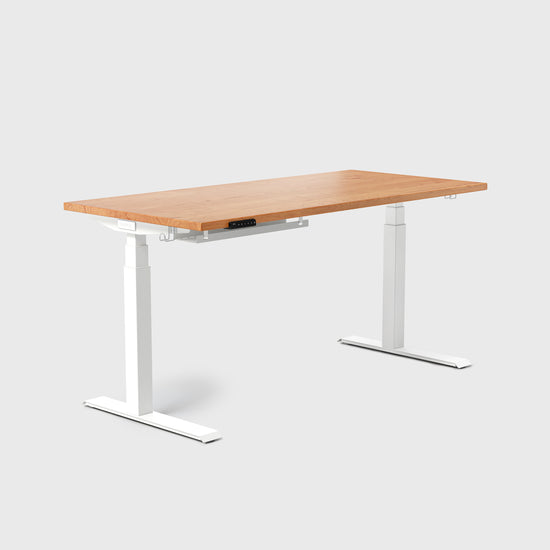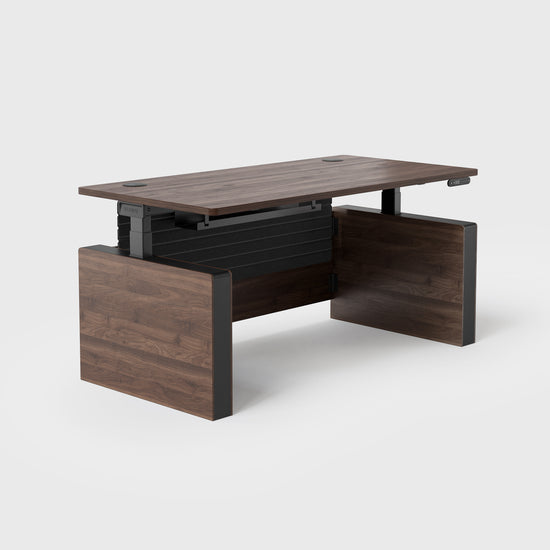Understanding the Lifting Capacity
When choosing a standing desk frame, knowing its lifting capacity is key to ensuring your desk can safely support your equipment. Lifting capacity not only affects stability, but also determines if the desk can handle multiple monitors, heavy devices, and everyday office needs.
What factors affect lifting capacity?
- Frame design: The type of support structure and frame connections impact lifting capacity. Vernal uses a dual-column, dual-motor system to distribute weight evenly, improving both load capacity and stability. High-quality welding, strong bolts, and anti-loosening designs ensure a sturdy, durable frame.
- Materials: The materials used affect weight tolerance. Desks with steel frames and solid wood tops are typically stronger and more stable than those made with lighter materials. Vernal uses SPCC cold-rolled carbon steel for excellent rigidity and resistance to deformation under heavier loads.
- Motor power: Load capacity also depends on motor torque and drive efficiency. Vernal combines high-quality motors with metal gears for strong load handling, while reducing the risk of overheating or stalling. The custom control box ensures precise motor synchronization, keeping the desktop level and avoiding overload on one side.
Rated Load vs. Maximum Load
Standing desks often list different load numbers—but what do they mean?

- Rated load: The maximum weight the desk can lift smoothly and safely in daily use, with evenly distributed weight. This ensures durability and aligns with long-term product testing standards.
- Maximum load: The absolute weight limit the desk can statically support without the desktop lowering under pressure. This is meant for short-term or emergency scenarios, not regular use.
For example, Vernal’s standard desk can handle a rated load of 120 kg (264.5 lbs), and L-shaped models can handle up to 150 kg (330 lbs). Within these limits, you can expect:
- Smooth, reliable lifting
- Structural durability without deformation or damage over time
- Full 15-year warranty coverage when used as recommended
If you exceed the rated load (but stay under maximum load), the desk may still work—but with risks:
- The motor may overheat, slow down, or get noisier
- Lifting could become jerky or noisy
- The frame may face extra stress, shortening lifespan
- Overloading can void the warranty
Vernal desks feature overload protection to warn users via error codes on the controller.
What Does a 120 kg (264.5 lbs) Rated Lifting Capacity Mean?
How do you know if a desk meets your needs? Just add up the weight of your gear! Here’s a quick guide to common item weights:
| Item |
Weight (kg)
|
Weight (lb)
|
|
Small monitor (21-24")
|
2.3 - 4.5
|
5 - 10
|
|
32" monitor
|
9
|
20
|
|
Monitor arm
|
4.5
|
10
|
|
Desktop PC
|
13.6
|
30
|
|
Laptop
|
1 - 3
|
2 - 7
|
|
Printer
|
2.5 - 10
|
5.5 -22
|
|
Books/files
|
5 - 20
|
11 - 44
|
|
Drawer organizer
|
2 - 10
|
4.5 - 22
|
|
Keyboard & mouse
|
1.5
|
3
|
|
Lamp
|
0.5 - 2
|
1 - 4.5
|
|
Mug/plants
|
1 - 5
|
2.2 - 11
|
|
Hard drives
|
4.5 - 6.8
|
10 - 15
|
Even if you load up your desk with 2 large monitors, 2 small monitors, 4 heavy-duty monitor arms, a laptop, a desktop, 2 heavy printers, books, organizers, accessories, and more—you’re still under 264.5 lbs.
Example total: 2*10 + 2*20 +4*10+30+7+2*22+20+10+3+4.5+10+10 = 238.5 lbs
Rather than advertising flashy maximum load numbers (which risk damaging the desk or impairing function), Vernal focuses on real, daily-use data that matches your needs. While easily handling loads beyond what most users require, Vernal desks still deliver smooth, quiet, and stable lifting—striking the ideal balance between speed, stability, and noise.
Choose Vernal New Edition—invest in reliable lifting, peace of mind, and a better work experience.

- Regular price
-
From
$899.99 - Regular price
-
$1,289.99 - Sale price
-
From
$899.99

- Regular price
-
From
$699.99 - Regular price
-
$899.99 - Sale price
-
From
$699.99



